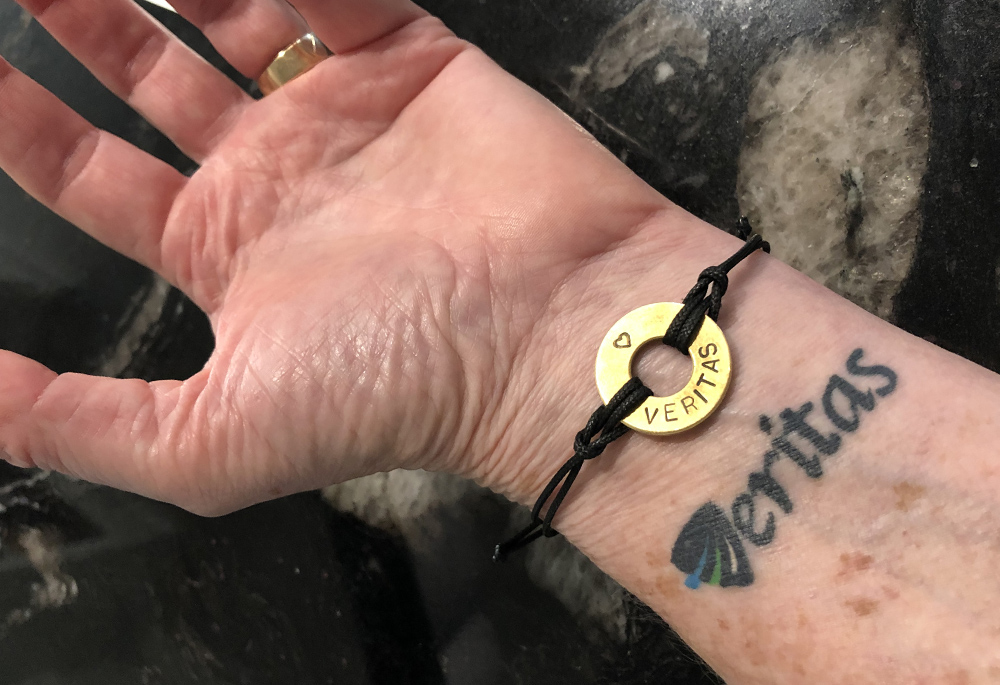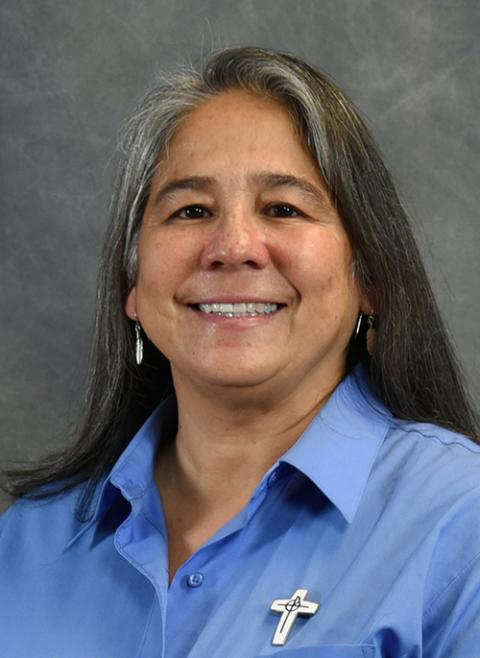
The “Veritas” tattoo Sinsinawa Dominican Sister Christina Heltsley got on her 65th birthday (Courtesy of Christina Heltsley)
It might not seem that tattoos are a subject connected with women religious and 20 years ago, I would have agreed.
That was before I got my first tattoo (at age 42) — I now have 10. It was also a time when most business dress codes mandated any visible tattoos be covered during work hours. For me, that meant wearing long sleeves, even on hot summer days.
These days, tattoos no longer carry the stigma of being "taboo" or deviant. And, while every individual has a different reason for seeking a tattoo — from remembering a deceased loved one or honoring family members, to making bold social statements — they are very often marvelous works of art.
As one celebrity with more than 35 tattoos explained: His body is a journal, and the tattoos are stories imprinted on that journal.
I agree with that, especially since the designs for my tattoos document the various inspirations I've had for hundreds of fictional stories I've written over the course of 50 years, from classic authors like Robert Louis Stevenson and Jules Verne to more current figures.
To be honest, I was a bit surprised when, at table a few months ago, I noticed one of the women in formation with the Benedictines at Mount St. Scholastica had a few tattoos: on her inside forearms and on the top of one foot. It made me curious to see what women religious think of this expressive art form.

Sr. Joni Luna, director of vocations, Sisters of Providence of St. Mary-of-the-Woods, Indiana (Courtesy of Joni Luna)
What I discovered is that — when it comes to women inquiring about vocations — a religious community may not have a set policy. For instance, Sr. Joni Luna, director of vocations for the Sisters of Providence of St. Mary-of-the-Woods in Indiana, told me her community would take into account where a tattoo was located, the design, and if it included foul language. She noted how some women who've joined the community in the past 15 years have tattoos, and they weren't required to have them removed.
Sr. Caryn Crook, vocation director of the Sisters of St. Francis of the Neumann Communities , mentioned that her community has accepted women with tattoos into their community, adding, "They were small or covered."
What may be even more unusual: a professed sister getting "inked!" Sinsinawa Dominican Sister Christina Heltsley, who ministers as executive director of St. Francis Center in Redwood City, California, has been a member of her community for 45 years.
"I was one of those people who said, 'I would never get a tattoo,' " she related. Growing up, she thought people who worked on ships, gang members or bikers were the only ones who got tattooed.
Then, for her 65th birthday — two years ago — her co-workers presented her with a gift bag. Inside, she found some lotion. After thanking them, she was told to look deeper. Another container of lotion was found. Again, thanks. Again, she was told to look deeper. That's when she found the gift card for a tattoo.
The design she chose was the word "Veritas" — truth — with the blue, white and green logo of her community integrated into the "V." It is placed on the inside of her left wrist.
"I love it," Sister Christina said.
The art is a source of levity among her fellow Dominicans. When flying into Dubuque, Iowa, earlier this year — the closest airport to Sinsinawa — she recalled, "I was met by Sisters Elayne, Deb and Peggy, holding a large sign which read, 'Looking for a sister with a tattoo.' "
Other sisters in her community understand the significance of the tattoo, as well. Sister Christina is aware how younger women entering religious life seek a sense of belonging and — though a habit in not her particular "thing" — the tattoo can serve as that symbol of unity and service. A couple of other sisters are considering getting tattoos, she said.
Advertisement
In my personal experience, I’ve discovered that tattoos, when visible, can be icebreakers or conversation starters. One person with a tattoo feels an almost immediate bond with a chance acquaintance who's also inked.
The story of one person's tattoo can lead to sharing about another's design. Laughter, even tears, can be involved in the tale. That can lead to interaction on a deeper, spiritual level.
Having a tattoo, for some, makes a religious more approachable, more grounded. Someone who might adamantly avoid a sister in a habit, can view those with a tattoo as a kindred spirit, more attuned to the flaws and weaknesses of ordinary folk, and more compassionate, less judgmental.
(This is not to imply that sisters in habits aren’t compassionate and very down-to-earth, but sometimes it's a matter of perception on the part of the laity.)
Since sharing the good news is integral to religious life — whether a community is apostolic, monastic or contemplative — having a means to reach those who might otherwise maintain their distance can only be a plus.
Innovation in ways to evangelize is, after all, part of the challenge faced by women religious today. I can imagine those in need filing through the line in a soup kitchen, to see a sister with a tattoo ladling bowls of soup. At the conclusion of the meal, a troubled soul - who might otherwise immediately move on to the next opportunity for shelter or clothes - lingers to unburden himself or herself to a willing ear, finding the wise advice or practical assistance that permanently changes a life.
It cannot be denied, however, some people might view a religious who sports tattoos with trepidation or derision. The issue harkens back to a previous column I wrote, about the tendency to assign labels to those encountered on a daily basis.
We all have different ways of expressing our emotions, life events, our faith, and these should be respected. A sister’s very uniqueness in having a tattoo — as opposed to the strict conformity among religious in centuries past — can open doors that might otherwise remain firmly closed against the love of Jesus for all.







